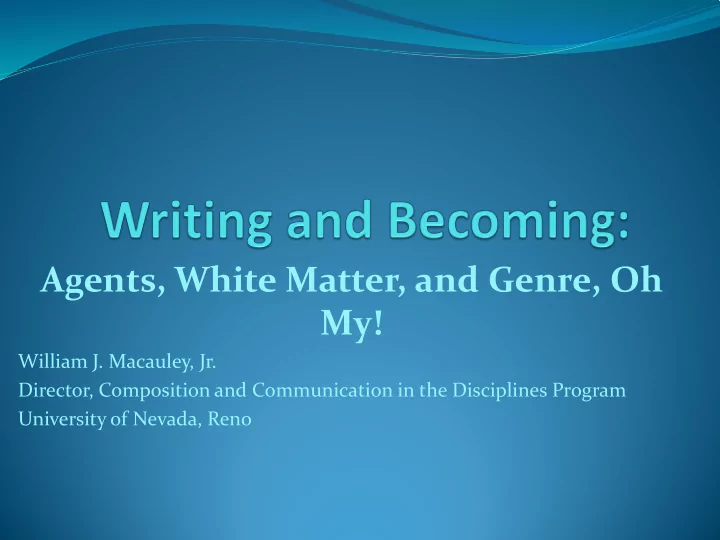

Agents, White Matter, and Genre, Oh My! William J. Macauley, Jr. Director, Composition and Communication in the Disciplines Program University of Nevada, Reno
Student writer agency and self-efficacy Agency: recognizing a role (Bandura 1987) Mastery Vicarious Social Physiological(Usher & Pajares, 2008) Self-efficacy: acting on that role (Bandura 2006) Intention Forethought Self-reactivity Self-reflectivity Modes (Bandura 2006) Individual Proxy Collective WID/WAC may rely on student writer agency and self-efficacy to a greater extent than FYC or disciplinary content, to analyze, move knowledge, see/learn genre, and understand context: varying rhetoric, transfer, genre, discourse, etc..
Social Psychology (2500+) Operationalized Bandura’s concepts in tangible ways Agency, self-efficacy, and applied specifically to academic writing Still outside the head and trying to look inside Frequently perception scales, questionnaires, self-perception surveys Extremely focused research Repetition is essential
Learning Theory/Studies Sprague & Stuart, 2000
Learning Theory/Studies Dualities: good/bad, right/wrong Multiplicity: it’s a matter of opinion and everybody has one Dweck: “Fixed mindset” Relativism: all views are not equal and can be evaluated Commitment: reasoned selection and building (Ambrose, et al., 2010) Dweck: “Growth mindset”
What is the brain doing? Physical brain development continues into early 20s (Mar, 2004; Blakemore and Robbins, 2012) Shift from grey matter to white matter production (Bartzokis et al., 2001; Giedd et al., 1999) Myelinisation (Bennett and Baird, 2006) Synaptic pruning (Bennett and Baird, 2006)
WAC/WID often works to develop Rhetorical facility: ethos, logos, pathos (Aristotle) Transfer/portability: students’ active movement of learning (Salomon & Perkins) Genre: context dependent (Waldo) Discourse community: disciplinary texts constituting and describing social actions (Soliday) All depend on a student writer’s agency (‘I act’) and self-efficacy (‘I decide how to act’).
Further complications: young adult psychology Emotional before executive Risk-taking—debated Evolutionary, life-stage Frame of reference, roles
Axes WAC/WID/CAC must consider
So, what does it all mean? WAC/WID are programs populated by individuals. A WAC/WID program can engage multiple perspectives in and about writing by design for those individuals. So, tell me something I don’t know . . . NSSE: not arrogance or ignorance but opportunity to support developing agency/self-efficacy Encourage internal locus of control Repeat and reinforce processes Reason over emotion may not be as simple as choice Expertise begins with awareness of ignorance Design thinking: empathy, define, ideate, prototype, test (Stanford d.school)
Recommend
More recommend